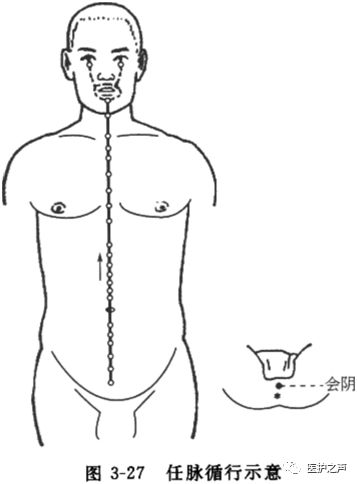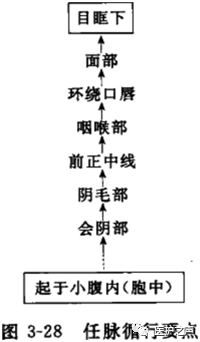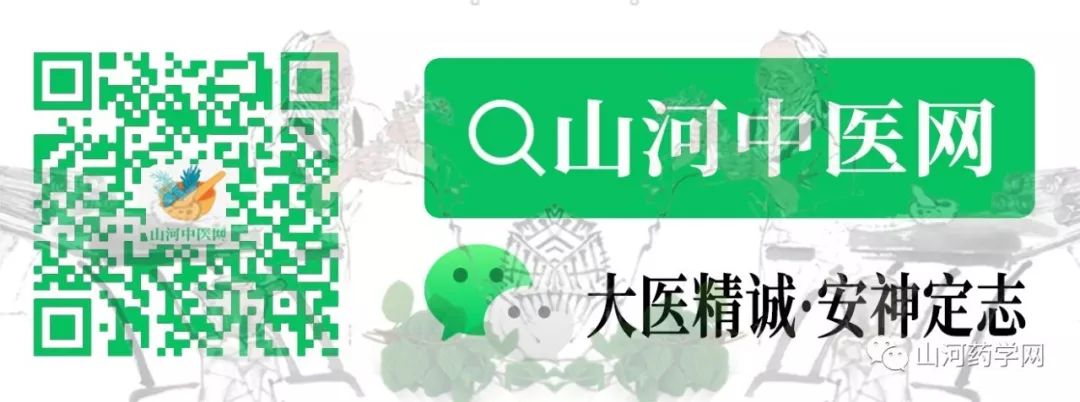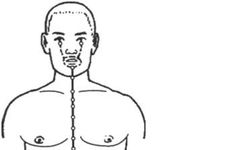II. Ren Meridian 【Pathway】 (Su Wen · Gu Kong Lun): The Ren Meridian originates below the Zhongji (Middle Pole), ascends through the pubic hair region, enters the abdomen, ascends to the Guanyuan (Gate of Origin), and reaches the throat, then ascends to the jaw and enters the eye. Translation: It starts from within the lower abdomen, exits at the perineum, ascends through the pubic hair region, along the midline of the abdomen, reaching the throat, then ascends around the lips, entering the eye socket below. See Figure 3-27.Key points of the Ren Meridian pathway are shown in Figure 3-28.

【Key Points of the Meridian】 See Table 3-27.
Table 3-27 Key Points of the Ren Meridian
|
Associated Organs |
Uterus |
|
Passes Through |
① Lips; ② Eyes |
|
Main Symptoms |
Hernia, leukorrhea, abdominal masses, etc. |
|
Indications Summary |
1. Local diseases of the abdomen, chest, neck, and face 2. Corresponding internal organ diseases 3. Some acupoints have strengthening effects or can treat mental disorders |
【Acupoints of this Meridian】 It starts at the perineum and ends at the Chengjiang (Receiving Fluid), with a total of 24 acupoints, see Table 3-28.
Table 3-28 Acupoints of the Ren Meridian
|
Acupoint |
Specific Acupoint |
Location |
Indications |
Needling Method |
|
|
1.Perineum |
At the perineum, midpoint between the root of the scrotum and the anus for males; midpoint between the posterior labia and the anus for females. |
Premature ejaculation, impotence; gynecological disorders, abnormal urination. |
① Itching, pain, sweating, protrusion, prolapse, hernia, hemorrhoids. ② Drowning, coma, epilepsy. |
Supine with knees flexed. |
Perpendicular insertion 0.5-1 inch, moxibustion possible; use with caution in pregnant women. |
|
2.Qugu |
On the anterior midline, at the midpoint above the pubic symphysis. |
Hernia, lower abdominal distension. |
Supine position. |
||
|
3.Zhongji |
Bladder Mu point. |
On the anterior midline, 4 inches below the umbilicus. |
① Urinary retention, enuresis. ② Hernia. |
||
|
4.Guanyuan |
Small intestine Mu point. |
On the anterior midline, 3 inches below the umbilicus. |
① Stroke with collapse, deficiency and emaciation. ② Abdominal pain, vomiting, diarrhea. ③ Hernia, infertility. |
Supine position, urinate before needling. |
|
|
5.Shimen |
On the anterior midline, 2 inches below the umbilicus. |
① Abdominal pain, diarrhea. ② Edema, hernia. |
|||
|
6.Qihai |
Blindness origin point. |
On the anterior midline, 1.5 inches below the umbilicus. |
① Qi deficiency urinary retention, enuresis; prolapse, stroke with collapse. ② Abdominal pain, constipation, diarrhea. ③ Hernia, infertility. |
Perpendicular insertion 0.8-1.2 inches, use with caution in pregnant women; moxibustion possible. |
|
|
7.Yinjiao |
On the anterior midline, 1 inch below the umbilicus. |
① Abdominal pain, hernia. ② Edema, urinary difficulty. ③ Gynecological disorders. |
Perpendicular insertion 0.5-1 inch; moxibustion possible. |
||
|
8.Shenque |
At the center of the abdomen, at the umbilicus. |
Abdominal pain, borborygmus, diarrhea. |
① Insufficient Yuan Yang or sudden collapse due to stroke, fainting, prolapse, corpse-like state. ② Edema. |
Do not needle; moxibustion recommended. |
|
|
9.Shuifeng |
On the anterior midline, 1 inch above the umbilicus. |
Edema due to abnormal fluid distribution, urinary difficulty. |
Perpendicular insertion 0.5-1 inch; moxibustion recommended. |
||
|
10.Xiawan |
On the anterior midline, 2 inches above the umbilicus. |
Abdominal pain, distension, borborygmus, diarrhea, vomiting due to spleen and stomach disorders. |
Masses. |
Perpendicular insertion 0.8-1.2 inches; moxibustion possible. |
|
|
11.Jianli |
On the anterior midline, 3 inches above the umbilicus. |
Edema. |
|||
|
12.Zhongwan |
Stomach Mu point; Hui point of the Fu organs. |
On the anterior midline, 4 inches above the umbilicus. |
① Jaundice. ② Epilepsy. |
Supine position. |
|
|
13.Shangwan |
On the anterior midline, 5 inches above the umbilicus. |
Epilepsy. |
Perpendicular insertion 0.5-1 inch; moxibustion possible. |
||
|
14.Juqie |
On the anterior midline, 5 inches above the umbilicus. |
Chest pain due to epilepsy. |
① Chest pain, palpitations. ② Vomiting, acid regurgitation, esophageal obstruction. |
Perpendicular insertion 0.5-0.6 inches, oblique insertion downwards, moxibustion possible. |
|
|
15.Jiutai |
Ren Meridian Luo point, origin of the Gao. |
On the anterior midline, 1 inch below the junction of the sternum and xiphoid process. |
Abdominal distension. |
Perpendicular insertion 0.3-0.6 inches, oblique insertion downwards; moxibustion possible. |
|
|
16.Zhongting |
On the anterior midline, at the level of the 5th intercostal space, at the junction of the sternum and xiphoid process. |
Chest and rib distension, cough, asthma, chest pain. |
Stomach Qi counterflow causing esophageal obstruction, vomiting, infantile vomiting. |
Horizontal insertion 0.3-0.5 inches; moxibustion possible. |
|
|
17.Dan Zhong |
Pericardium Mu point, Qi meeting point. |
On the anterior midline, at the level of the 4th intercostal space, midpoint between the nipples. |
① Palpitations, heart pain. ② Vomiting, esophageal obstruction. ③ Insufficient lactation in postpartum women, mastitis. |
||
|
18.Yutang |
On the anterior midline, at the level of the 3rd intercostal space. |
Chest pain; cough; asthma. |
Restlessness, vomiting. |
||
|
19.Zigong |
On the anterior midline, at the level of the 2nd intercostal space. |
Restlessness. |
|
Acupoint |
Specific Acupoint |
Location |
Indications |
Needling and Moxibustion Method |
|
|
Common Symptoms |
Specific Symptoms |
Position |
Operation |
||
|
20.Huagai |
On the chest, at the level of the 1st intercostal space. |
Chest pain, cough, asthma. |
Chest and rib distension pain. |
Supine position. |
Horizontal insertion 0.3-0.5 inches; moxibustion possible. |
|
21.Xuanji |
On the anterior midline, 1 inch below the central depression of the suprasternal notch. |
Throat swelling and pain. |
|||
|
22.Tian Tu |
On the neck, on the anterior midline, at the central depression of the suprasternal notch. |
① Asthma. ② Sudden loss of voice, throat swelling and pain, goiter, plum pit qi. |
Supine or sitting position. First needle perpendicularly 0.2 inches, then angle the needle tip downwards, slowly insert 0.5-1 inch along the posterior edge of the sternum and anterior edge of the trachea; moxibustion possible. |
||
|
23.Kangquan |
On the neck, on the anterior midline, above the Adam’s apple, in the depression above the hyoid bone. |
① Swelling and pain under the tongue, urgent retraction of the tongue root, excessive salivation, loss of speech. ② Sudden loss of voice, throat obstruction. |
Oblique insertion towards the root of the tongue 0.5-0.8 inches; moxibustion possible. |
||
|
24.Chengjiang |
On the face, at the central depression of the mentolabial groove. |
① Mouth ulcers, toothache, salivation, facial paralysis, facial swelling, neck stiffness. ② Sudden loss of voice, epilepsy. |
Oblique insertion 0.3-0.5 inches; moxibustion possible. |
【Song of the Acupoints of the Ren Meridian】
The Ren Meridian starts at the perineum, between the two Yin, Qugu at the midpoint of the pubic hair, Zhongji 4 inches below the umbilicus, Guanyuan 3 inches below the umbilicus,
Shimen 2 inches below the umbilicus, Qihai 1.5 inches below the umbilicus, Yinjiao 1 inch below the umbilicus, Shenque at the center of the umbilicus,
Shuifeng 1 inch above the umbilicus, Xiawan 2 inches above the umbilicus, Jianli 3 inches above the umbilicus, Zhongwan 4 inches above the umbilicus,
Shangwan 5 inches above the umbilicus, Juqie 6 inches above the umbilicus, Jiutai 7 inches above the umbilicus, Zhongting at the junction of the sternum and xiphoid process,
Dan Zhong is between the two nipples, Yutang at the level of the 5th rib, Zigong at the level of the 2nd rib, Huagai at the angle of the sternum,
Xuanji at the center of the sternum, Tian Tu at the central depression of the suprasternal notch, Kangquan above the hyoid bone, Chengjiang at the central depression of the mentolabial groove.
Disclaimer:The content on this site is added and organized by users for learning and reference purposes. The information on the site may not be accurate, comprehensive, or up-to-date, and the content should not be the final basis for diagnosing or treating diseases.Shanhe TCM Networkreminds users that if you have any physical discomfort, please seek medical attention promptly. Thank you for your support and love; we will strive to do better~!!!


